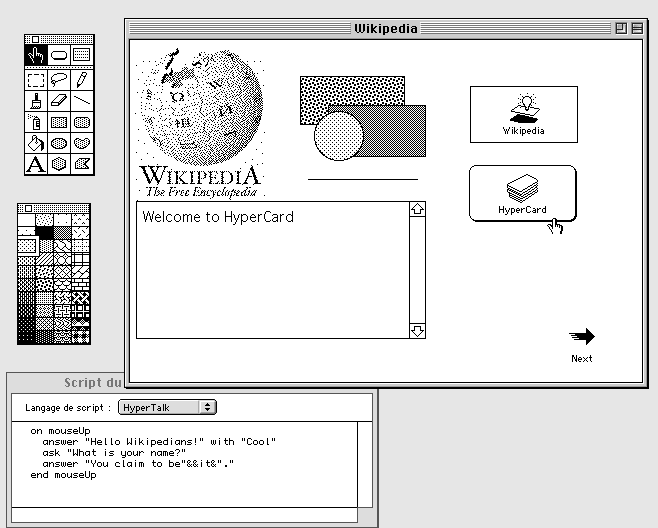NewMedia History : is it that new (6) ?
A screen shot of a HyperCard stack in development |
Bill Atkinson : HyperCard <1987>The first accessible hypermedia systemFreely available on all MacsA huge success (learning material, game, inventory systems etc)Lighting system for the Petronas Towers in Kuala Lumpur, Malaysia !Usual Apple mistake : proprietaryHypercard = B&W Web, with Javascript, XML, XLST but no URLHyperCard was created by Bill Atkinson and initially released in 1987, with the understanding that Atkinson would give HyperCard to Apple only if they promised to release it for free on all Macs (an agreement that, according to Atkinson, ran out when the largely-rewritten HyperCard 2.0 hit the shelves). HyperCard is one of the first products that made use of and popularized the hypertext concept to a large popular base of users. Hypercard saw a loss in popularity with the growth of the World Wide Web, since the web could handle and deliver data in much the same way as HyperCard without being limited to files on your hard disk. Interestingly, HyperCard had a significant impact on the web as it inspired the creation of both HTTP itself and JavaScript. |
Because it can be used to create custom applications in
minutes, HyperCard is still used by many academic researchers and small businesses.
Some companies run HyperCard applications -- that were written years ago on
a Mac Plus -- on the latest dual-processor G4 PowerMacs.
Renault, the French auto giant, reportedly uses HyperCard for its inventory
system. The software runs part of the lighting system for the tallest buildings
in the world, the Petronas Towers in Kuala Lumpur, Malaysia.
HyperCard is used widely in schools to teach programming concepts and for creating
interactive learning materials or class reports.
Source : Wired : http://www.wired.com/news/mac/0,2125,54365,00.html
HyperCard is based on the concept of a "stack"
of virtual "cards". Each card includes fields that store data, and
the pattern for each card (its layout, as opposed to the data in the layout)
is known as the "background". Backgrounds could include pictures (its
original purpose, "background picture"), picture fields, buttons,
text, text fields (editors) and other common GUI elements, which would then
be copied onto new cards.
Users can construct databases by opening the Background editor and drawing items
onto it to hold the various pieces of data. For instance, an address book could
be easily built up by adding a few text fields to hold the name and address.
Once completed, the user simply adds a new card (by typing command-n) and types
into the fields. The background could be modified at any time, allowing changes
to be made with ease – something traditional systems are very bad at.
Basic operations such as search, add and delete were built into the HyperCard
environment, allowing simple databases to be set up and used by anyone able
to use the Apple Macintosh computer.
Scripting in the HyperTalk language allowed the system to be easily modified
and extended. Unlike most programming languages, even those that claim to be
easy to use, HyperTalk really was easy to use. Allowable syntax included all
sorts of versions of the same statement, all in readable English, to avoid forcing
the user to write their programs in a particular format.
